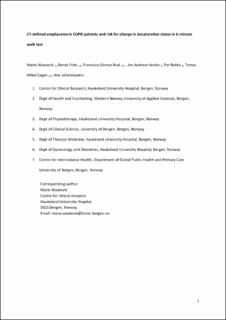| dc.contributor.author | Wåtevik, Marie | |
| dc.contributor.author | Frisk, Bente | |
| dc.contributor.author | Real, Francisco Gomez | |
| dc.contributor.author | Hardie, Jon Andrew | |
| dc.contributor.author | Bakke, Per | |
| dc.contributor.author | Eagan, Tomas Mikal Lind | |
| dc.contributor.author | Johannessen, Ane | |
| dc.date.accessioned | 2022-03-01T09:52:07Z | |
| dc.date.available | 2022-03-01T09:52:07Z | |
| dc.date.created | 2021-08-17T14:36:06Z | |
| dc.date.issued | 2021 | |
| dc.identifier.citation | Waatevik, M., Frisk, B., Real, F. G., Hardie, J. A., Bakke, P., Eagan, T. M., & Johannessen, A. (2021). CT-defined emphysema in COPD patients and risk for change in desaturation status in 6-min walk test. Respiratory Medicine, 187. | en_US |
| dc.identifier.issn | 0954-6111 | |
| dc.identifier.uri | https://hdl.handle.net/11250/2982000 | |
| dc.description | This is an accepted manuscript version of an article published by Elsevier in Respiratory Medicine on 23 July 2021. The manuscript version is made available under the CC-BY-NC-ND 4.0 license. | en_US |
| dc.description.abstract | Background
Emphysema and exercise induced desaturation (EID) are both related to poorer COPD prognosis. More knowledge of associations between emphysema and desaturation is needed for more efficient disease management.
Research question
Is emphysema a risk factor for both new and repeated desaturation, and is emphysema of more or less importance than other known risk factors?
Methods
283 COPD patients completed a 6-min walk test (6MWT) at baseline and one year later in the Bergen COPD cohort study 2006–2011. Degree of emphysema was assessed as percent of low attenuation areas (%LAA) under −950 Hounsfield units using high-resolution computed tomography at baseline.
We performed multinomial logistic regression analysis, receiver operating curves (ROC) and area under the curve (AUC) estimations. Dominance analysis was used to rank emphysema and risk factors in terms of importance.
Results
A one percent increase in %LAA increases the relative risk (RR) of new desaturation by 10 % (RR 1.1 (95%CI 1.1, 1.2)) and for repeated desaturation by 20 % (RR 1.2 (95%CI 1.1, 1.3)). Compared with other important desaturation risk factors, %LAA ranked as number one in the dominance analysis, accounting for 50 % and 37 % of the predicted variance for new and repeated desaturators, respectively. FEV1% predicted accounted for 9 % and 24 %, and resting SpO2 accounted for 22 % and 21 % for new and repeated desaturation.
Conclusion
Emphysema increases the risk of developing and repeatedly experiencing EID. Emphysema seems to be a more important risk factor for desaturation than FEV1% predicted and resting saturation. | en_US |
| dc.language.iso | eng | en_US |
| dc.publisher | Elsevier | en_US |
| dc.rights | Attribution-NonCommercial-NoDerivatives 4.0 Internasjonal | * |
| dc.rights.uri | http://creativecommons.org/licenses/by-nc-nd/4.0/deed.no | * |
| dc.title | CT-defined emphysema in COPD patients and risk for change in desaturation status in 6-min walk test | en_US |
| dc.type | Peer reviewed | en_US |
| dc.type | Journal article | en_US |
| dc.description.version | acceptedVersion | en_US |
| dc.rights.holder | © 2021 | en_US |
| dc.subject.nsi | VDP::Medisinske Fag: 700::Klinisk medisinske fag: 750::Lungesykdommer: 777 | en_US |
| dc.source.pagenumber | 8 | en_US |
| dc.source.volume | 187 | en_US |
| dc.source.journal | Respiratory Medicine | en_US |
| dc.identifier.doi | 10.1016/j.rmed.2021.106542 | |
| dc.identifier.cristin | 1926667 | |
| cristin.ispublished | true | |
| cristin.fulltext | preprint | |
| cristin.qualitycode | 1 | |

